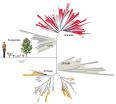The new groups make up more than 15 percent of all known groups or phyla of bacteria, the scientists say, and include the smallest life forms on Earth, microbes a mere 400 nanometers across. The number of new bacterial phyla is equal to all the known animal phyla on Earth.
The scientists, who recently also identified nine new groups of microbes known as Archaea, see these new additions to life on Earth as a sign that the accepted tree of life - a division into the three domains of eukaryotes, which includes animals and plants, bacteria and Archaea - needs to be revised.
"This is a new view of the tree of life," said lead author Jill Banfield, a professor of earth and planetary science and of environmental science, policy and management. "These new major features on the tree of life mean that it probably won't be the simple three-domain view we have now."
Graduate student Christopher Brown, Banfield and their colleagues will report the discovery online June 15 in advance of publication in the journal Nature. Banfield is also a researcher in the Earth Sciences Division at Lawrence Berkeley National Laboratory.
A new radiation of bacteria
Many of the newly identified bacteria were sighted before and tentatively classified as "candidate phyla" because little was known about them aside from a few gene sequences.
The UC Berkeley team realized that the only way to clarify such vague classifications was to sequence the genomes of these organisms, and they decided to collect samples from groundwater at a remediation site in Rifle, Colorado. Since they suspected that many of the unusual microbes were small, they analyzed samples that passed through 0.2 micron filters, which catch most bacteria and are often used to purify water.
Colleagues at the Department of Energy's Joint Genome Institute shotgun-sequenced the DNA of all the microbes in the filtered sample, a technique known as metagenomic analysis. Banfield's team then assembled the millions of DNA pieces into eight complete bacterial genomes from four new and one previously studied phyla, and draft genomes - most of them more than 90 percent complete - for 789 other bacteria. They are lumping the 35-plus phyla into a cluster they call the "candidate phyla radiation" because of their similarities to one another and stark differences from other bacteria.
"We were really surprised to find how diverse these groups are within the bacterial domain, and just how consistently different the organisms within this radiation are from the rest of bacteria," said Brown, who is in the Department of Plant and Microbial Biology at UC Berkeley. "No one had been able to put all the pieces together before."
These differences, which include the bacteria's small size and small genomes, may be the reason they can't be grown in lab culture: they are stripped-down life forms with the barebones requirement of genes, lacking the ability to make key building blocks, and probably dependent on other forms of life for help. The researchers estimate that there may be more than 250 separate phyla within this radiation.
Three domains of life
All life is divided into three domains, though everything we see around us is from only one of them: the eukaryotes, or organisms that have nuclei in their cells. Within the eukaryotes there are about 35 animal phyla - the phylum Chordata includes humans and all other vertebrates - 12 plant phyla and a few fungi. The microscopic bacterial domain has been much fuzzier because some organisms detected widely in the environment fail to grow in culture like other bacteria.
By some estimates there are 100 bacterial phyla, though only 29 have representatives that will grow in culture. The new discovery allowed the team not only to define about a third of all bacterial phyla but, thanks to the nearly complete genomes, to characterize their lifestyles.
"People have seen these bacteria in surveys of many different environments all over the planet, so we've known that they are there, and that they are fairly ubiquitous," Brown said. "What we didn't know is what the organisms were and what they were capable of doing."
About half of all the genes in these 35-plus phyla are new and unlike other known genes. The recognizable genes suggest that most of the bacteria use a simple process of fermentation to make the energy they need, instead of using aerobic or anaerobic respiration like many other bacteria. They also have unusual ribosomes, the multi-protein machines that translate genetic instructions into proteins. In fact, routine genomic scans would not detect them because of their distinctive 16S ribosomal RNA genes. The UC Berkeley team found that some of the bacteria have very rare inserts, called introns, in genes coding for 16S ribosomal RNA, which make them invisible to current detection techniques.
"We found that all of these have at least a couple of unusual ribosomal features, and many are missing ribosomal proteins that are thought to be either universal across the tree of life or in all of bacteria," Banfield said.
"The unusual ribosomes, the small genomes - between 600 and 1,100 genes - the inability to synthesize amino acids and nucleotides, and a consistent metabolic story really connects these bacteria together in a pretty surprising way," Brown said.
Banfield has been studying unusual microbial communities for decades, probing not only the acidic pools in abandoned mines and the contaminated groundwater at the Superfund cleanup site in Colorado, but also the gut of premature infants. In the process, she and her team have come to realize the amazing diversity and lifestyles of these microbes.
"I think what this is telling us is that a large part of bacteria and bacterial lifestyles are very different from what we thought before. There is a lot of biology that we haven't been able to understand from our current methods," Brown said.
The team has already named over 20 of the new phyla, most after award-winning microbiologists but one - Berkelbacteria - after UC Berkeley.
INFORMATION:
Other co-authors are Laura Hug, Brian Thomas, Itai Sharon, Cindy Castelle and Andrea Singh of UC Berkeley's Department of Earth and Planetary Science; Michael Wilkins and Kelly Wrighton of the Ohio State University in Columbus; and Kenneth Williams of Lawrence Berkeley National Laboratory. The work is supported by the Department of Energy.

